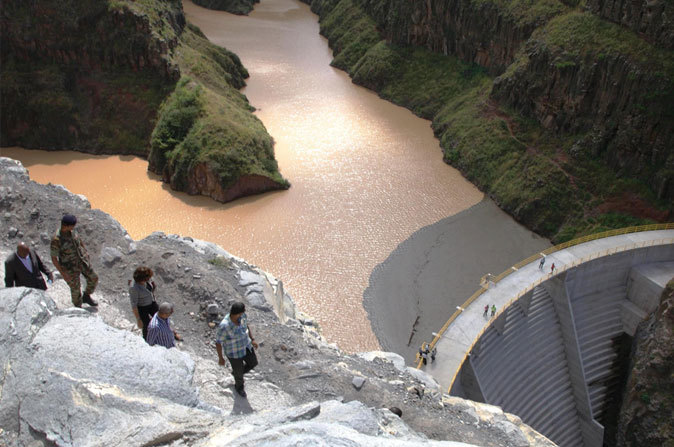Agriculture & Fisheries / Cape Verde
Water for life
17 new dams will supply thousands of farmers

Saquinho dam, a new infrastructure inaugurated on Santiago Island in November 2013.
Cape Verde is working around irregular natural water supply. Through the years cyclical droughts in the country have caused famine and hardship. Unsuitable agricultural methods were introduced in the 18th century, aggravating the problem. Ever since, anything water-related takes on a greater significance, in a country with no rivers, lakes or any other large bodies of water.
Rainfall occurs only three months every year. July, August and September are usually wet months, but occasionally an entire year may pass without any rain at all. When this happens, agricultural activity and, consequently, the well being of the country’s inhabitants are endangered. Additionally, even in wet months the effects of relatively heavy rain are quite short-lived, as due to the nature of the terrain most of the water runs off into the sea.
From the mid-70s to the mid-90s, the country compensated for its scarcity of water resources by means of the ‘Frentes de Alta Intensidade de Mão de Obra’, labour-intensive public works schemes which additionally trained and relocated thousands of unemployed country labourers in other sectors of the economy. Nevertheless, the new millennium will require more stable long-term solutions.
The country has been constructing a series of major new water infrastructures since 2004, as part of the Government’s Agricultural Water Mobilisation scheme. Poilão, the first of 17 new dams to be in operation by 2017, was built in the heart of Santiago, and holds up to 1.7 million cubic metres of water, supplying up to 2,600 families or 15,000 inhabitants.
Further improvements have also been planned for Poilão. The installation of solar and wind-powered pumping stations will benefit a further 10,000 inhabitants, increasing the total of irrigated hectares from 160 to 623.
Reaching four crops per year
Faveta, Salineiro and Saquinho dams in Santiago island are the most recent achievements of the Government’s efforts. All were inaugurated between June and November 2013, and will provide irrigation for 187 hectares and thousands of people in the area. Canto Cagarra dam, on Santo Antão, will join them in the coming months, bringing total annual capacity up to 2.3 million cubic metres in a first phase. They will irrigate more than 230 hectares with a cost of almost $27 million.
Another two dams will also be inaugurated in 2014: Figueira Gorda on Santiago and Banca Furada on São Nicolau Island. When operative, Figueira Gorda will be the biggest dam in the country and benefit 480 local farmers.
The Water Mobilisation Programme also includes the construction of new pumping stations, reservoirs, distribution networks, dykes and flood routing. In conjunction with the new dams, these infrastructures should allow for an uptake of more than 75 million cubic metres of rainwater yearly.
This will mean that land, which at present can only be worked for a few months each year, will now yield up to four crops annually. New plant varieties are also being cultivated, including some fruit species. Supplying the markets with local products also means prices can be controlled, and drip irrigation means enormous savings in water resources.
Another crucial strategy is desalination, which currently provides drinking water for more than half of the Cape Verdean population. In 2012, more than 4 millions of cubic metres of desalinated water were distributed in Praia and on São Vicente and Sal Islands.
